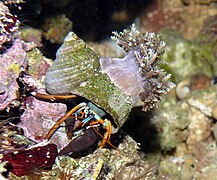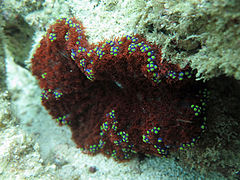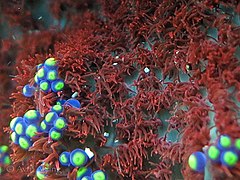Thalassianthus aster is a species of sea anemone in the family Thalassianthidae.[2] It dwells in a number of habitats, even existing symbiotically on top of other motile invertebrates such as hermit crabs in a relationship similar to the pom pom crab. Its nematocysts contain a Type-II Na+-channel toxin known as δ-TLTX-Ta1a according to the currently developing systematic nomenclature for peptide and protein toxins from sea anemones.[3]
-
On a hermit crab
-
Red color morph
-
Stinging nematocysts
| Thalassianthus aster | |
|---|---|

| |
| Scientific classification | |
| Domain: | Eukaryota |
| Kingdom: | Animalia |
| Phylum: | Cnidaria |
| Class: | Hexacorallia |
| Order: | Actiniaria |
| Family: | Thalassianthidae |
| Genus: | Thalassianthus |
| Species: | T. aster
|
| Binomial name | |
| Thalassianthus aster | |
| Synonyms | |
| |
References
edit- ^ IUCN 2017. [1] The IUCN Red List of Threatened Species. Version 2016.1.
- ^ World Register of Marine Species. (2013). Thalassianthus aster Rüppell & Leuckart, 1828. http://www.marinespecies.org/aphia.php?p=taxdetails&id=291206
- ^ Dos Santos, Wagner Ferreira (2009). "Spider and Wasp Neurotoxins". Botulinum Toxin. pp. 471–484. doi:10.1016/B978-1-4160-4928-9.00038-X. ISBN 9781416049289.



